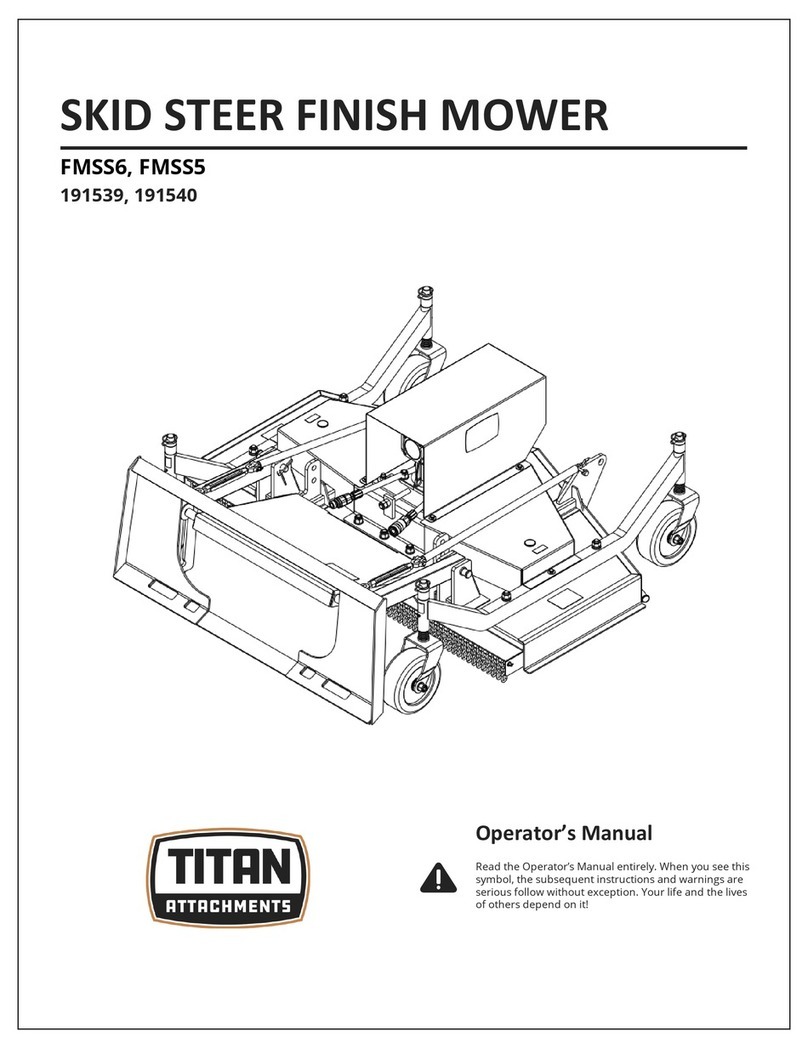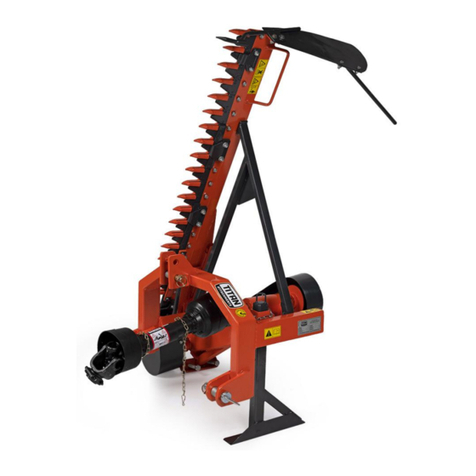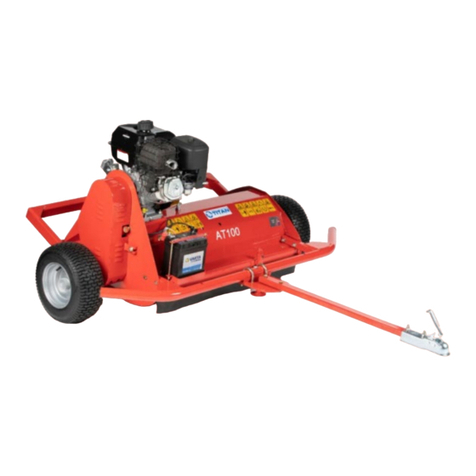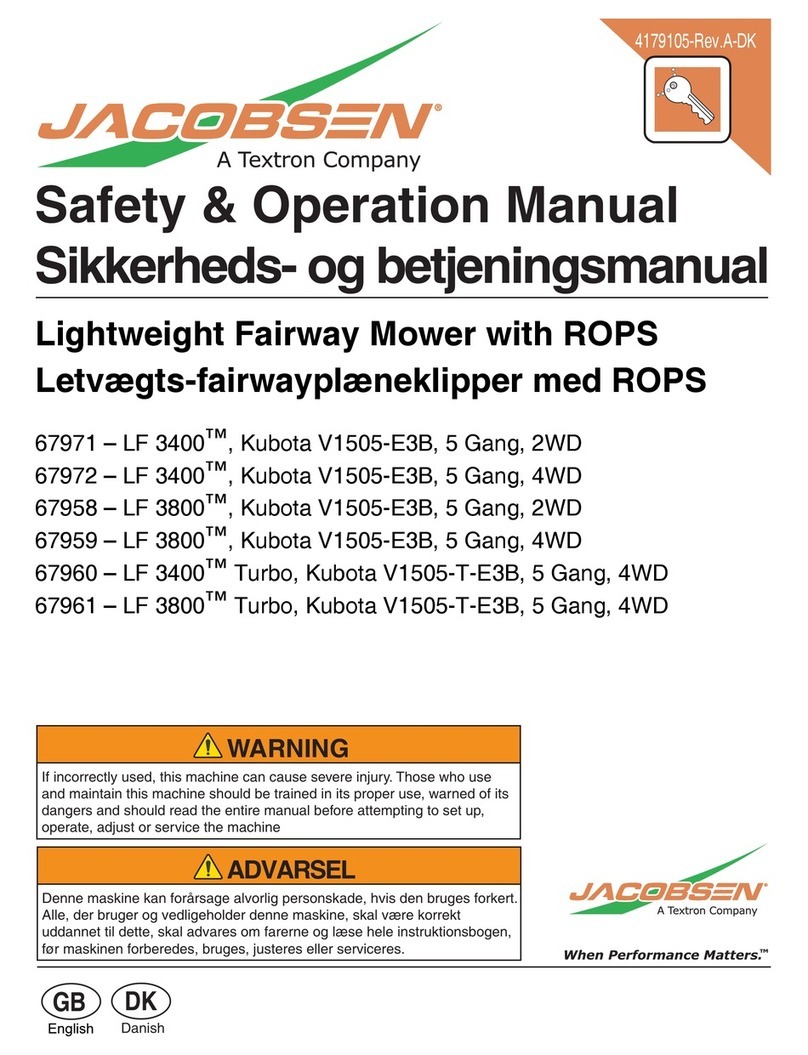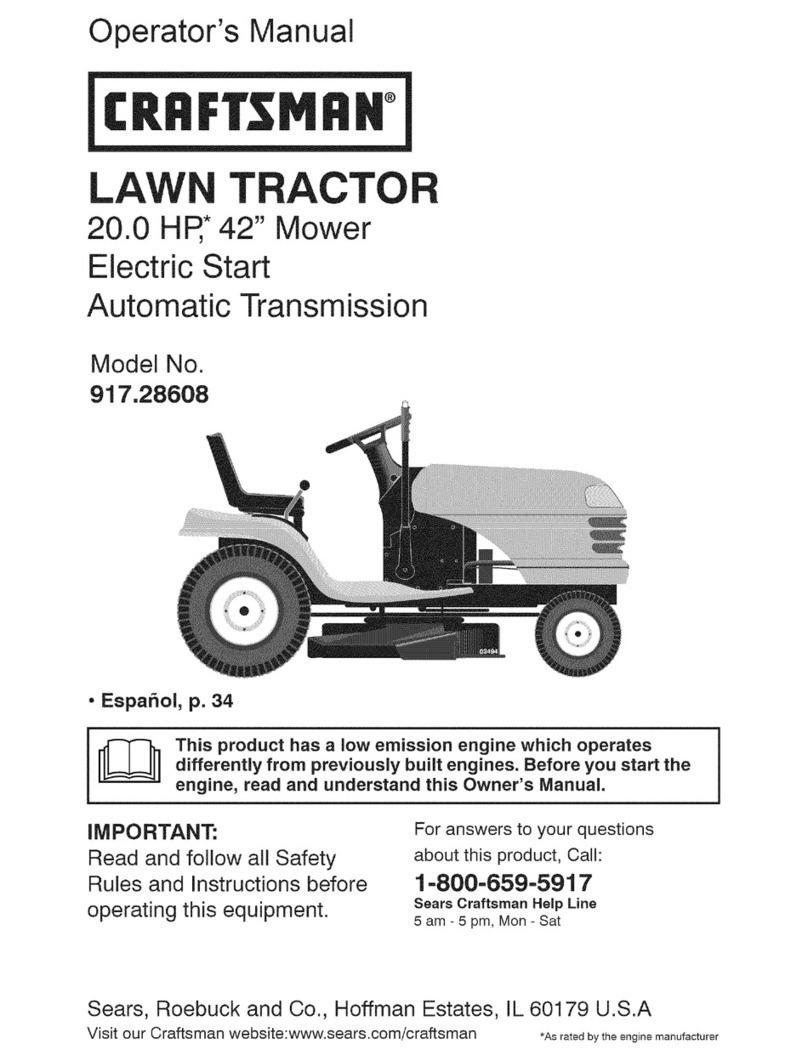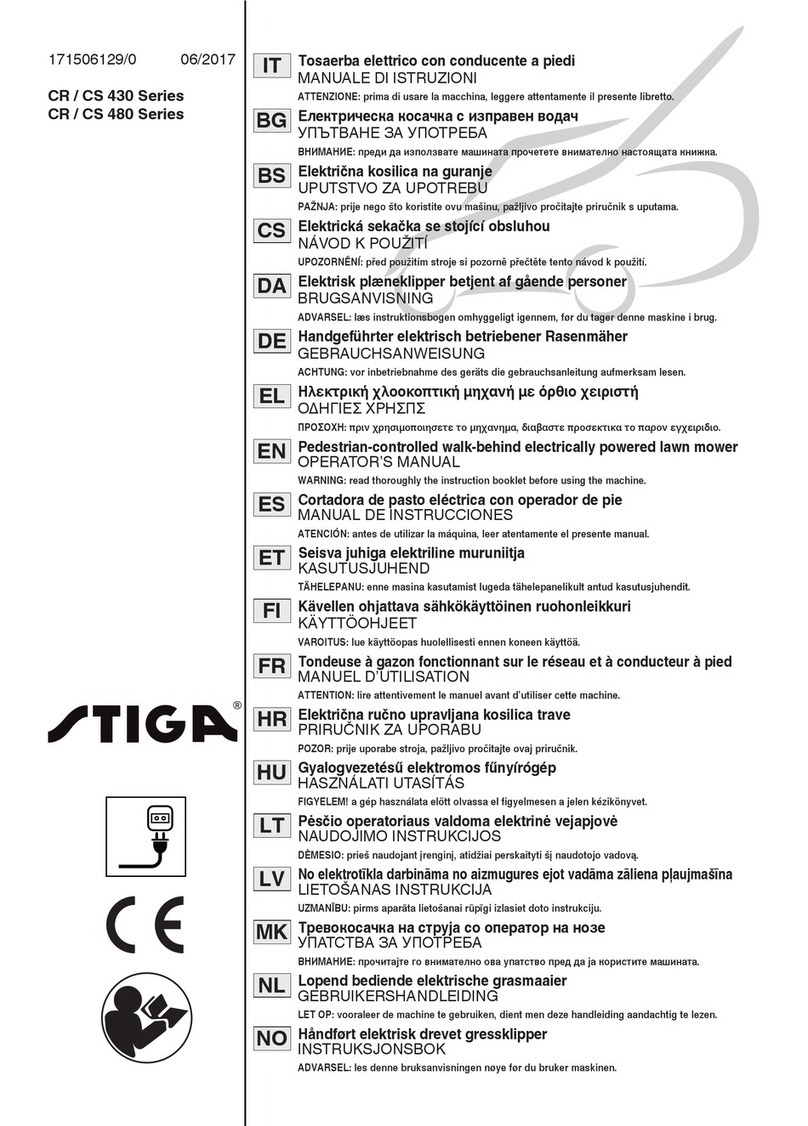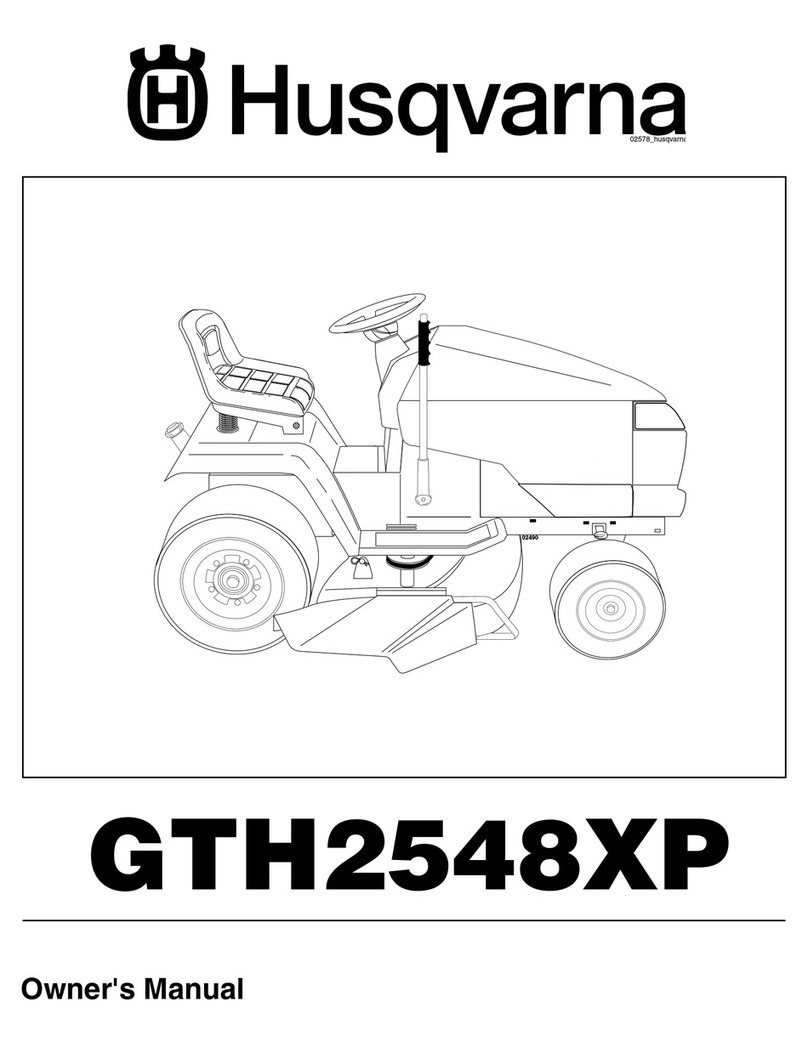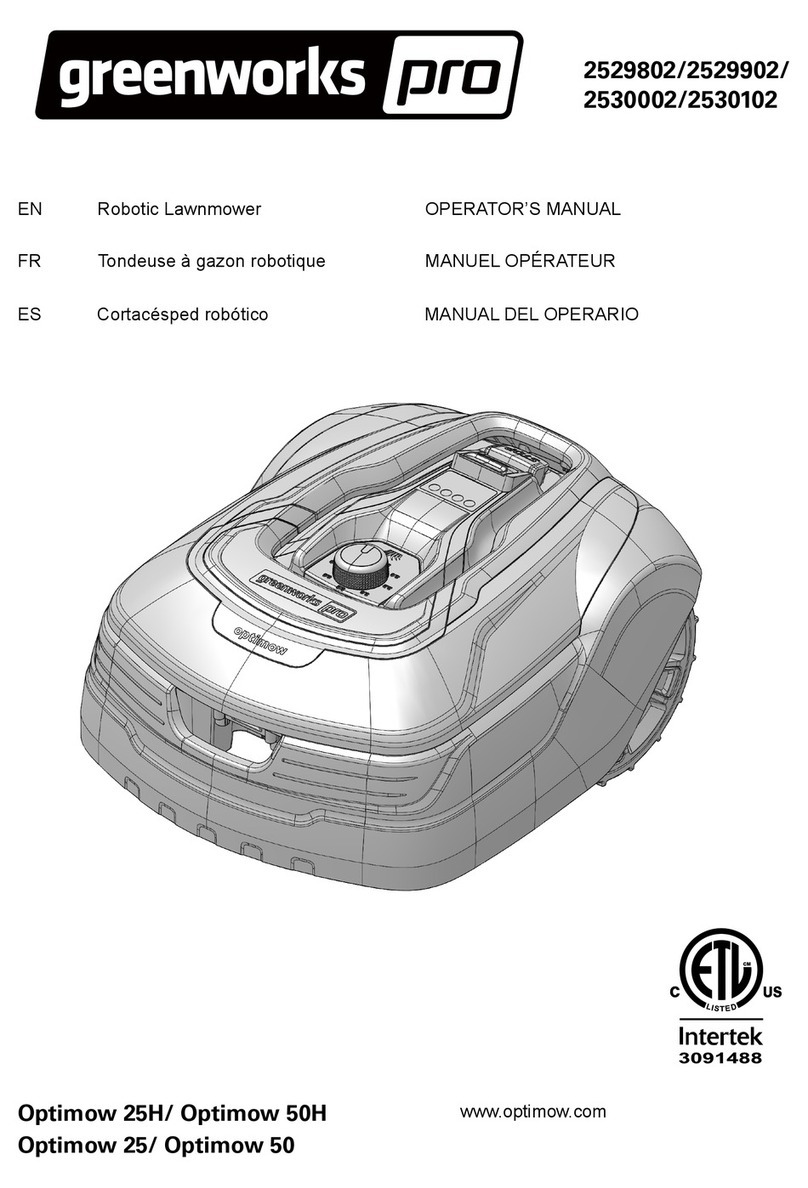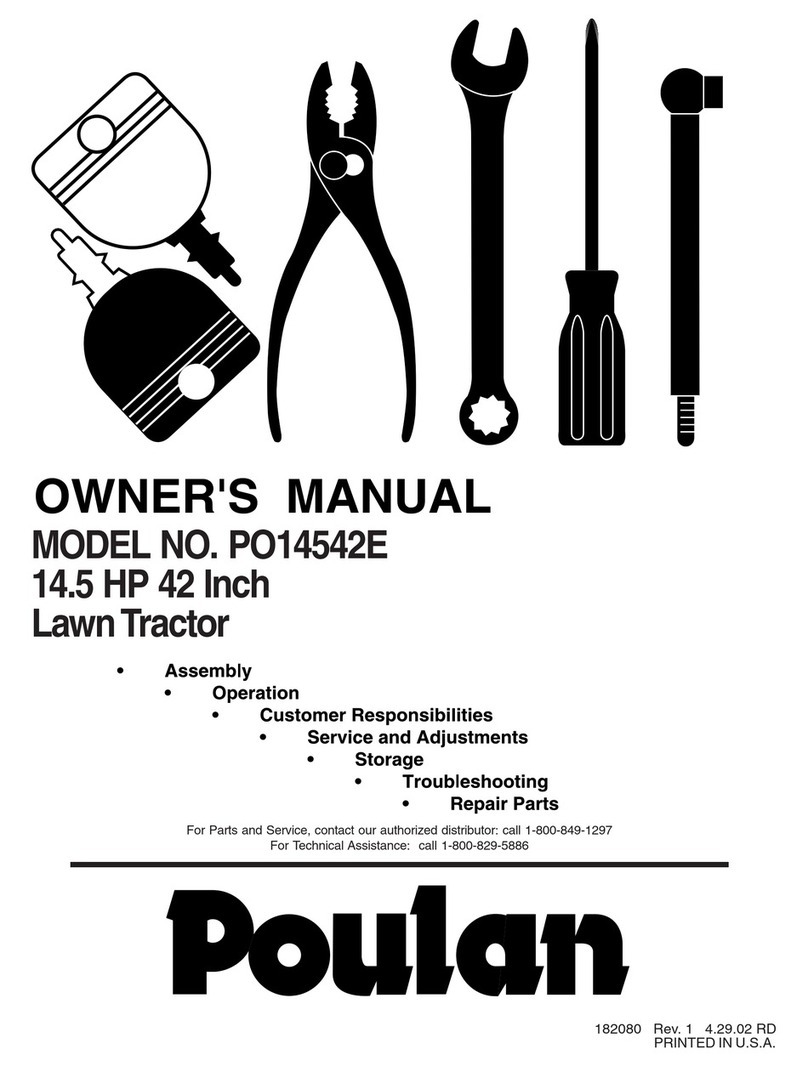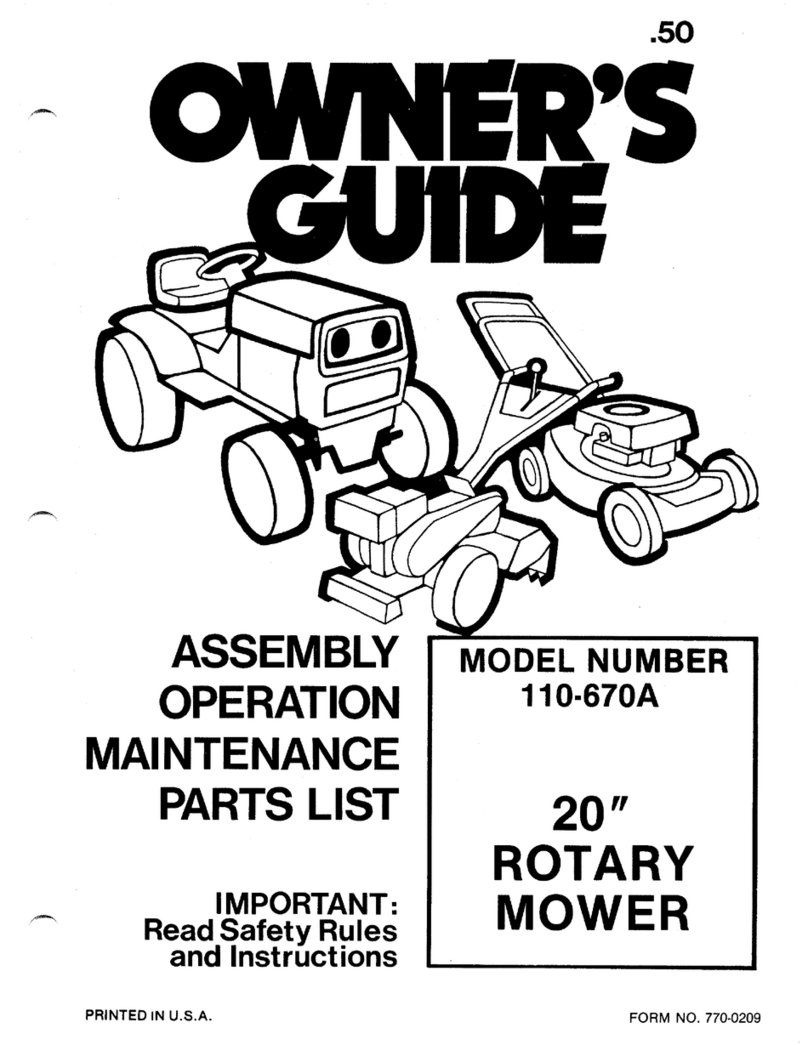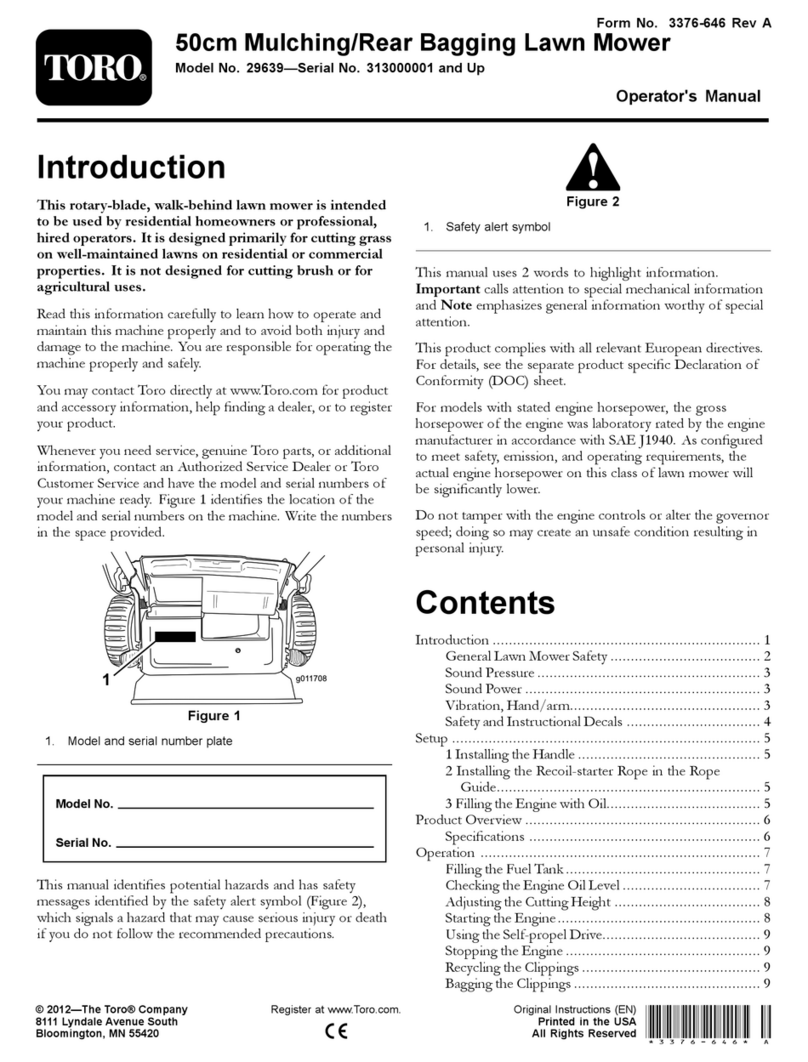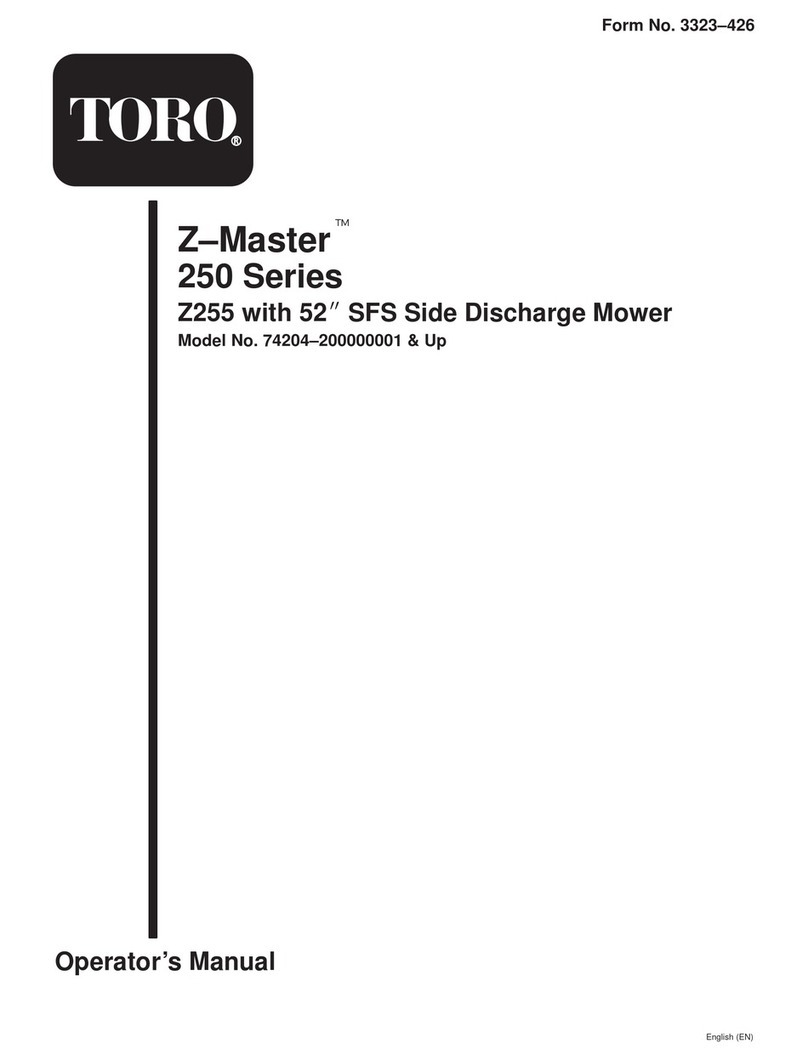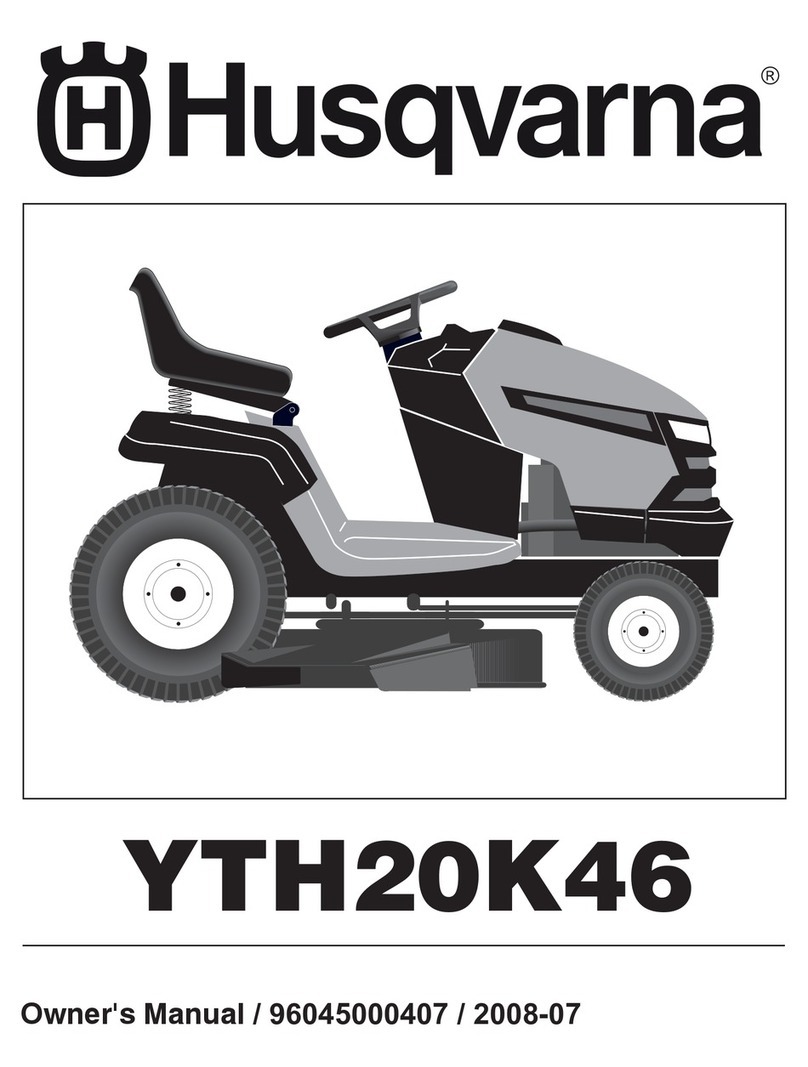Titan Attachments ATVFLAIL48 User manual

ATV TOWABLE FLAIL MOWER
ATVFLAIL48
191633
Operator’s Manual
Read the Operator’s Manual entirely. When you see this
symbol, the subsequent instructions and warnings are
serious follow without exception. Your life and the lives
of others depend on it!

2
IMPORTANT SAFETY INFORMATION
THESE ARE STANDARD PRACTICES THAT MAY NOT APPLY TO THE PRODUCTS
DESCRIBED IN THIS MANUAL.
SAFETY AT ALL TIMES
Thoroughly read and understand the instructions given in this manual before operation. Refer
to the “Safety Label” section, read all instructions noted on them.
Do not allow anyone to operate this equipment who has not thoroughly read and
comprehended this manual. Do not allow anyone who has not adequately trained in the safe
operation of the equipment.
•The operator should be familiar with all functions of the unit.
•Operate implement from the driver’s seat only.
•Make sure all guards and shields are in place and secured before operating the tool.
•Do not leave a tractor or implement unattended with the engine running.
•Dismounting from a moving tractor could cause severe injury or death.
•Do not allow anyone to stand between tractor and implement while backing up to
implement.
•Keep hands, feet, and clothing away from power-driven parts.
•Wear snug-fitting clothing to avoid entanglement with moving parts.
•Watch out for wires, trees, etc., when raising implements. Make sure all persons are clear
of the working area.
•Turning the tractor too tight may cause implement to ride upon wheels. This activity could
result in injury or equipment damage.
•Do not carry passengers on the tool at any time.
LOOK FOR THE SAFETY ALERT SYMBOL
The SAFETY ALERT SYMBOL indicates a potential hazard to personal safety, and individuals
must take safety precautions. When you see this symbol, be alert and carefully read the
message that follows it. In addition to the design and configuration of equipment, hazard
control and accident prevention depend on the awareness, concern, prudence, and proper
training of personnel involved in the operation, transport, maintenance, and storage.

3
BE AWARE OF SAFETY ALERT WORDS
A Signal word designates a degree or level of hazard seriousness. The signal words are:
DANGER: Indicates imminently hazardous practices. A situation that, if not avoided, will result
in death or severe injury. The signal word is limited to the most extreme situation, typically for
machine components that, for functional purposes, cannot be guarded.
WARNING: Indicates a potentially hazardous situation that, if not avoided, could result in death
or severe injury, and includes hazards that are exposed when guards remove. Use warnings to
alert against unsafe practices.
CAUTION: Indicates a potentially hazardous situation that may result in minor or moderate
injury if not avoided. It may also be used to alert against unsafe practices.
FOR YOUR PROTECTION
Thoroughly read and understand the “Safety Label” section, read all instructions noted on them.
SHUTDOWN AND STORAGE
•Lower machine to the ground, put the tractor in park, turn off the engine, and remove the
key.
•Detach and store implements in an area where children typically do not play. Secure
implement by using blocks and supports.
USE SAFETY LIGHTS AND DEVICES
•Slow-moving tractors, self-propelled equipment, and towed implements can create a
hazard when driven on public roads. They are challenging to see, especially at night.
•Flashing warning lights and we recommend turn signals whenever driving on the public
road.
TRANSPORT MACHINERY SAFELY
•Comply with state and local laws
•The maximum transport speed for implement is 20 mph, DO NOT EXCEED. Never travel at
a rate that does not allow adequate control of steering and stopping. Some rough terrain
requires a slower speed.
•Sudden braking can cause a towed load to swerve and upset. Reduce speed if the towed
load is not equipped with brakes.
Use the following maximum speed –tow load weight ratios as a guideline:
•20 mph when weight is less than or equal to the weight of the tractor.
•10 mph when weight is double the weight of the tractor.
IMPORTANT: Do not tow a load that is more than double the weight of the tractor.

4
PRACTICE SAFE MAINTENANCE
•Understand procedure before doing work. Use proper tools and equipment, refer to
Operator’s Manual for additional information.
•Work in a clean dry area.
•Lower the implement to the ground, put tractor in park, turn off engine, and remove key
before performing maintenance.
•Allow implement to cool completely.
•Do not grease or oil implement while it is in operation.
•Inspect all part. Make sure parts are in good condition & installed properly.
•Remove buildup of grease, oil, or debris.
•Remove all tools and unused parts from implement before operation.
KEEP RIDERS OFF MACHINERY
•Riders obstruct the operator’s view, they cold be struck by foreign objects or thrown from
the machine.
•Never allow children to operate equipment.
PREPARE FOR EMERGENCIES
•Be prepared if a fire starts.
•Keep a first aid kit and fire extinguisher handy
•Keep emergency numbers for doctor, ambulance, hospital, and fire department near the
phone.
WEAR PROTECTIVE EQUIPMENT
•Wear protective clothing and equipment appropriate for the job. Avoid loose-fitting
clothing.
•Prolonged exposure to loud noise can cause hearing impairment or hearing loss. Wear
suitable hearing protection such as earmuffs or earplugs.
•Operating equipment safety requires the full attention of the operator. Avoid wearing
radio headphones while operating machinery.
AVOID HIGH-PRESSURE FLUIDS HAZARD
•Escaping fluid under pressure can penetrate the skin causing severe injury.
•Avoid the hazard by relieving pressure before disconnecting hydraulic lines or performing
work on the system.
•Ensure all hydraulic fluid connections are tight and all hydraulic hoses and lines are in
good condition before applying pressure to the system.
•Use a piece of paper or cardboard, NOT BODY PARTS, to check for suspected leaks.
•Wear protective gloves and safety glasses or goggles when working with hydraulic
systems.
•If an accident occurs, see a doctor immediately. Remember, any fluid injected into the skin
must be treated within a few hours, or gangrene may result

5
TIRE SAFETY
•Tire changing can be dangerous, and trained personnel should be the only ones using
correct tools and equipment.
•When inflating tires, use a clip-on chuck and extension hose long enough to allow you to
stand to one side and NOT in front of or over the tire assembly. Use a safety cage if
available.
•When removing and installing wheels, use wheel handling equipment adequate for the
weight involved

6
IMPORTANT SAFETY INFORMATION
SAFETY LABELS
Your Flail Mower comes equipped with all safety labels in place. They were designed to help you
safety operate your implement. Read and follow the directions.
1. Refer to this section for proper label placement.
2. Some new equipment installed during repair requires safety labels fo be affixed to the
replace component as specified by . When ordering new components make sure the correct
safety labels are included in the request.
3. Refer to this section for proper label placement. To install new labels:
a. Clean the area the label is to be placed.
b. Spray soapy water on the surface where the label is the be placed.
c. Peel backing from label. Press firmly onto the surface.
d. Squeeze out air bubbles with the edge of a credit card or with a similar type straight
edge.

7

8
IMPORTANT SAFETY INFORMATION
INTRODUCTION
welcomes you to the growing family of new product owners. This Flail Mower has been designed
with care and built by skilled workers using quality materials. Proper assembly, maintenance, and
safe operating practices will help you get years of satisfactory use from this machine.
APPLICATION
The medium duty ATV120 Flail Mowers are designed and built to provide excellent cutting
performance on gently sloping or slightly contoured right-of ways, roadsides, ditches, pastures,
nurseries, and smaller fields of row crop debris, stalks, and residual agricultural growth. ATV120
equipped with a 25HP to 45HP tractor. Specially designed for cutting orchard, on both sides of
highway slope, ditch.
This model equipped with fine cutting knives will perform extremely well cutting material up to 1” in
diameter or provide a very respectable quality o cut for grooming yards, municipal parks, medians,
and right of ways.
This model also can be equipped with forged hammer knives and heavy-duty brush rake teeth to
make them well suited for nursery and agricultural applications where heavy grass, brush, pruning,
saplings, small stumps, corn stocks, and other row crop debris are present. The rake teeth will gather
and aggressively force material into the rotor hammer knives for a more complete pulverization.
USING THIS MANUAL
•This Operator’s Manual is designed to help familiarize you with safety, assembly, operation,
adjustments, troubleshooting, and maintenance. Read this manual and follow the
recommendations to help ensure safe and efficient operation.
•The information contained within this manual was current at the time of printing. Some
parts may change slightly to assure you of the best performance.
•To order a new Operator’s or Parts Manual contact your authorized dealer. Manuals can also
be downloaded, free-of-charge from our website at www..com.
TERMINOLOGY
“Right” or “Left” as used in this manual is determined by facing the direction the machine will
operate when used unless otherwise stated.
DEFINITIONS

9
OWNER ASSISTANCE
The Online Warranty Registration or Warranty Registration card should be completed by the dealer
at the time of purchase. This information is too necessary provide you with quality customer service.
The parts on your Flail Mower have been specially designed by and should only be replaced with
genuine parts. Contact a dealer if customer service or repair parts are required. Your dealer has
trained personnel, repair parts, and equipment needed to service the implement.
SERIAL NUMBER
Model No. ________ Serial No. _________For quick reference and prompt service, record model
and serial number in the spaces provided above and again on warranty page 38. Always provide
model and serial number when ordering parts and in all correspondences with your dealer. Refer to
Figure 1 for location of your serial number plate.
FURTHER ASSISTANCE
Your dealer wants you to be satisfied with your new Mowers. If for any reason you do not
understand any part of this manual or are not satisfied with the service received, the following
actions are suggested:
1. Discuss the matter with your dealership service manager making sure that person is aware of
any problems you may have and has had the opportunity to assist you.
2. If you are still not satisfied, seek out the owner or general manager of the dealership, explain
the problem, and request assistance.
3. For further assistance write

10
SECTION 1: ASSEMBLY & SET-UP
TRACTOR REQUIREMENTS
Tractor horsepower and hitch category should be within the range noted below. Tractors outside the
horsepower range must not be used. The lower 3- Point arms must be stabilized to prevent side-to-
side movement. Most tractors have sway blocks or adjustable chains for this purpose.
Horsepower Rating . . . . . . . . . . . . . . . . . . .25-45 HP
Tractor Weight . . . . . . . . . See Important Note Below
TRACTOR HOOK-UP
Refer to Figure 1-2:
1. Ensure that the three-point suspension bar of the tractor does not affect the interference
between the machine and the tow bar. Remove the three-point suspension bar if necessary.
2. Connect the towing hook of the machine to the towing frame of the tractor.

11
SECTION 2: OPERATING INSTRUCTIONS
PRE-START CHECKLIST
Hazard control and accident prevention are dependent upon the awareness, concern, prudence, and
proper training involved in the operation, transport, storage, and maintenance of the Mowers.
Therefore, it is absolutely essential that no one operates the poultry litter Crusher without first
having read, fully understood, and Become totally familiar with the Operator’s Manual. Make sure
the operator has read and paid particular attention to:
•Important Safety Information
•Section 1: Assembly & Set-up
•Section 2: Operating Instructions
•Section 3: Adjustments
•Section 4: Maintenance & Lubrication
Make sure the operator has completed the Operating Checklist below.

12
TRACTOR SHUT DOWN PROCEDURE
It is essential that the tractor be shut down as noted below before making any inspections,
maintenance and/or repairs to the tractor and/or Mowers.
1. Park tractor on a level surface.
a. Don’t work under or around an implement parked on a steep incline.
2. Place tractor in park and set park brake.
3. Shut engine off and remove switch key.
4. Wear safety glasses.
TRANSPORTING
! CAUTION
When traveling on public roads whether at night or during the day, use accessory light and devices
for adequate warning to operators of other vehicles. Comply with all federal, state, and local laws.
1. Be sure to reduce tractor ground speed when turning, leaving enough clearance so that the
Mowers does not contact obstacles such as buildings, trees, or fences.
2. Select a safe ground travel speed when transporting from one area to another. When
traveling on roadways, transporting such a way that faster moving vehicles may pass safely.
3. When traveling over rough or hilly terrain, shift tractor to a lower gear.
SAFETY INFORMATION
! DANGER
The engine must be stopped and the blades at a standstill before adjusting to the transport position.
! DANGER
Never carry a person on the Mowers. A rider can fall or become entangled in the machine causing
serious injury or death.
! DANGER
Do not operate and/or travel across steep inclines where a tractor can roll-over resulting in serious
injury or death. Consult your tractor’s manual for acceptable inclines the tractor can travel across.
! DANGER
Do not use Mowers to lift or carry objects. Lifting and/or carrying objects can result in damage to the
Mowers, serious bodily injury, or death.
! DANGER
Do not use Mowers as a working platform. The Mowers is not properly designed or guarded for this.
Using the Mowers as a working platform can cause serious injury or death.

13
WORKING INSTRUCTIONS
1. Clear area to be worked of objects and debris that might be picked up and thrown by the
Mowers blades. Do not use Mowers on stony ground.
2. Make the following machine checks before operating the Mowers.
a. All hook-up pins should be secured.
b. All shields should be in place and secured.
c. All bolts and lock nuts should be present and tight.
d. Make sure the blades are not broken or loose.
OPERATING INSTRUCTIONS
Proper servicing and adjustments are the key to the long life of any machine. With careful and
systematic inspection of the Mowers, costly maintenance, time, and repair can be avoided.
! BEFORE BEGINNING TO WORK, THE FOLLOWING INSPECTION AND CHECKS SHOULD BE
PERFORMED:
1. Be sure all Mowers blades, bolts, and lock nuts are tight.
2. Be certain all guards and shields are in place and secure.
3. Grease driveline shaft and all other grease fittings.
4. Clear area to be worked of rocks, branches, and other foreign objects. Do not use Mowers on
stony ground.
5. After working the first 50 feet, stop and check to see that the Mowers is adjusted properly.
6. Do not make sharp turns or attempt to back up while Mowers is on the ground.
7. Never work close to or on steep slopes.
8. Do not allow anyone including yourself near the Mowers when it is operating.
GENERAL OPERATING INSTRUCTIONS
It’s now time to do a running operational safety check. If at any time during this safety check you
detect a malfunction in either the Mowers or tractor, shut the tractor off immediately, remove the
key, and make necessary repairs or adjustments before continuing.
Ensure the tractor is stopped and the lawn mower is connected to the tractor. Minimize the throttle
modulation of the gasoline engine. Use the key to start the engine and gradually increase the
throttle, ensuring the engine speed increases; when the engine speed is 2000r/min, and the cutter
shaft clutch is closed, the cutter shaft will start to work. The engine speed will reach the maximum
torque when the operating speed is 2800r/min. It is recommended to use this speed for maximum
working resistance. The higher the engine speed, the easier it is for the blade to cut the grass. You
should now be ready to move to the crushing site to begin working. It would be best if you had
inspected and should only be Crushing in an area you are familiar with, which is relatively free of
debris and unseen objects. Never assume an area is clear. If you strike an object, stop the tractor and
Mowers immediately to inspect the rotor and make any necessary repairs before resuming
operation. It pays to check a new area and to develop a plan before you cut. The average working
speed will be between 2-5 mph.
Generally, the cut quality will be better at lower ground speeds and crushing denser ground cover or
heavier brush may create the need to slow down. Always cut downward on slopes and avoid
crossing the face of steep slopes. Avoid sharp drop sand cross diagonally through dips to prevent

14
hanging up the tractor and Mowers. Slowdown in turns and avoid sharp turns if possible. Remember
to look back often.
SECTION 3: ADJUSTMENTS
! CAUTION
1. Engage parking brake, shut off tractor, remove key.
2. Ensure Mowers with special supports if it is
necessary to lift Mowers off the ground to adjust!
If not supported, the Mowers
LEVELING THE MOWERS
Adjust the height of the lawn mower by adjusting the tires
1. Park tractor and Mowers on a flat level surface.
2. Adjust the handle of the lawn mower tire, first
adjust one side to the specified height, and then
adjust the handle on the other side reaches the
specified height.
3. Ensure that the lower arms are stabilized to
prevent excessive side movement.
4. Adjust the screw on the traction frame and adjust
the front and rear inclination of the machine.
BELT TENSION ADJUSTMENT
! WARNING
Excessive tension on the belt may lead to premature
failure of belt and drive components. Excessive tension on
the belt may also lead to a safety hazard to the operator or
bystanders.
The Belt tension should be checked after the first 20 hours
of use and every 40 hours thereafter.
1. Check belt tension by applying approximately 22
pounds of pressure halfway between the pulleys.
The belt should deflect approximately 3/8".
2. Belt tension can be adjusted at the belt tension
bolt. Turn belt tension bolt until desired belt
tension is achieved.
CRUSHING HEIGHT ADJUSTMENT
The machines cutting height depends upon the position of
Adjustment plate.
1. Remove bolts that fix the roller height on both sides.
2. Lift or lower both sides of roller inequal measurements.
3. Replace bolts and re-tighten to the proper torque

15
SECTION 3: ADJUSTMENTS
BATTERY WIRING METHOD

16
SECTION 3: ADJUSTMENTS
ROTOR BLADE REPLACEMENT
Frequently check rotor blades to make sure they are in good working condition and properly secured
to the rotor. Replace worn or damaged parts with new blades.
The blade has a crushing edge on both the leading and trailing edges. When the leading edge wears
out, turn existing pair of blades around 180 degrees and reinstall. Replaced blade should be the
same length as existing part to maintain rotor balance.
ATV120 SERIES BLADE REPLACEMENT
1. REMOVE NUT (#4), BOLT (#1), and SPACER (#2) for Y type blade system.
2. Remove existing blades or turn existing pair of blades around 180 degrees and reinstall.
3. Install blade with existing bolt, washers, and locknut.
4. Tighten locknut with correct torque.

17
SECTION 4: MAINTENANCE & LUBRICATION
STORAGE MACHINE BEARING LUBRICATION
It is good practice to clean off any dirt and grease
that may have accumulated on the Mowers and to
inspect and make necessary repairs before parking
the unit at the end of the working season and for
long periods. This will help ensure that the
Mowers will be ready for use the next time you
hook-up to it.
1. Remove any dirt and grease that may have
accumulated on the Mowers and moving
parts Scrape off compacted dirt from under
the hood and then wash the surface
thoroughly with a garden hose.
2. Check rotor blade and blade bolts for wear
and replace if necessary. See “Rotor blade
Replacement” on
3. Inspect Mowers for loose, damaged, or
worn parts and adjust or replace as
needed.
4. Repaint parts where paint is worn or
scratched to prevent rust. Ask your dealer
for aerosol touch-up paint It are also
available in touch-up bottles with brush,
quarts, and gallon sizes by adding TU, QT,
or GL to the end of the aerosol part
number.
5. Replace all damaged or missing labels.
6. A light coat of oil or grease may also be
applied to areas where paint has worn off
to minimize oxidation. 7. Lubricate as
noted under “Lubrication Points”.
7. Store equipment on a level surface in a
clean, dry place. Inside storage will reduce
maintenance and make for a longer mower
life. Ensure that the main frame is stable.
8. Store drivelines end off the ground.

18
SECTION 5: DETAILED PARAMETERS

19
SECTION 6: PARTS LIST
Page No. 1

20
SECTION 6: PARTS LIST
Page No. 2
This manual suits for next models
1
Table of contents
Other Titan Attachments Lawn Mower manuals
